Key takeaways:
- Understanding each vendor’s communication style enhances collaboration and creativity.
- Clear communication builds trust and fosters partnerships, preventing miscommunications that can derail plans.
- Building personal relationships with vendors transforms transactional interactions into lasting partnerships, yielding better outcomes.
- Utilizing modern tools for communication streamlines the planning process and encourages real-time collaboration.
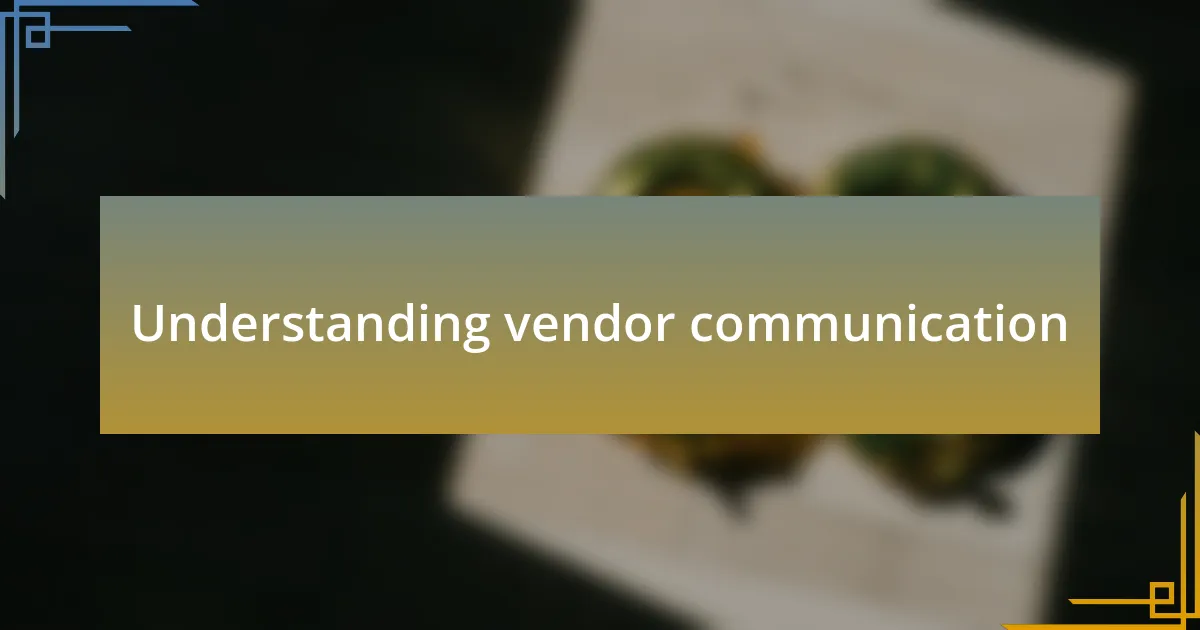
Understanding vendor communication
Effective vendor communication is foundational in the wedding planning process. I remember when I first started managing vendor relationships; I realized that understanding each vendor’s communication style was crucial. Some vendors prefer emails, while others thrive on phone calls; aligning these styles can make all the difference in collaboration.
When I engaged with a florist early in my career, their passion was palpable through their words. I found that asking open-ended questions not only showed my interest but also encouraged them to share more creative ideas. Have you ever noticed how a simple “What inspires you?” can lead to unexpected and beautiful suggestions? It’s these moments that reveal the true essence of a vendor’s work.
Trust is another key element in vendor communication. I learned the importance of transparency in my dealings, especially when there were challenges. When an unexpected issue arose with a caterer, being upfront about my concerns led to a constructive dialogue that ultimately resulted in a better solution for both parties. Doesn’t it feel more reassuring when you know you can communicate openly without fear of misunderstanding?
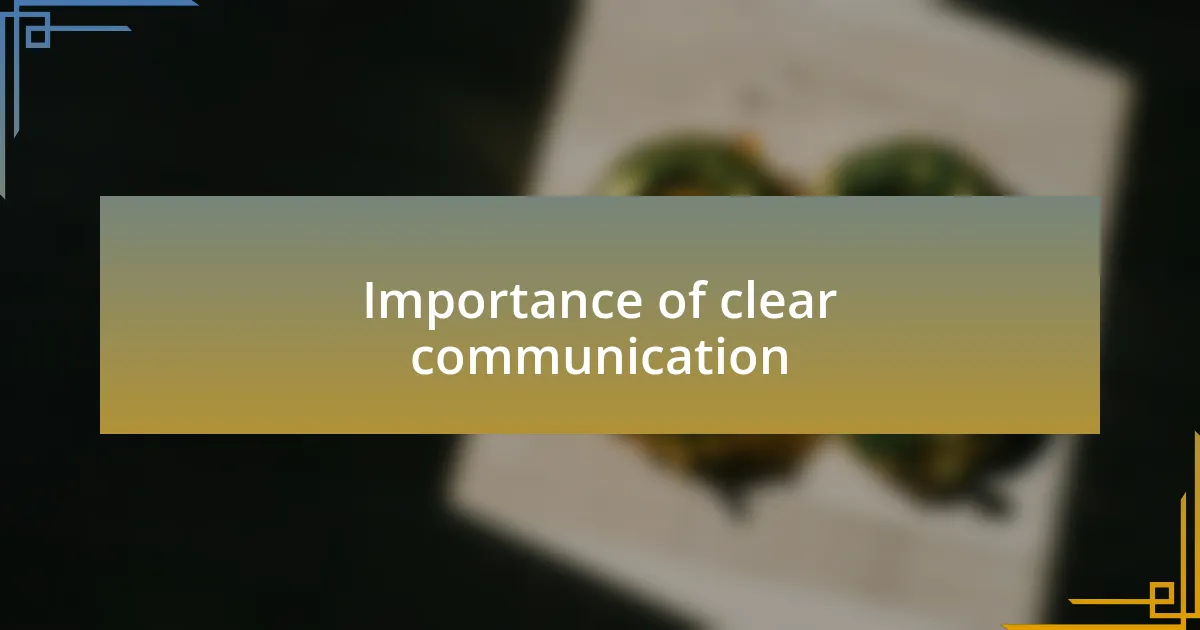
Importance of clear communication
Clear communication is the glue that holds vendor relationships together, especially in the context of wedding planning. I once planned a wedding where a miscommunication led to the wrong flowers being delivered just days before the ceremony. The panic was palpable, but it was through clear discussions with the florist that we managed to pivot quickly. Have you ever found yourself in a similar situation where clarity could have averted chaos?
When everyone is on the same page, it invites a sense of partnership. I remember working with a photographer who had a distinct vision; by clearly articulating our timeline and expectations, we created a seamless experience. I’ve often reflected on how that collaboration not only enhanced the wedding day but also established a bond that led to future referrals. Can you imagine the difference a straightforward conversation could make in fostering such connections?
In essence, clear communication fosters transparency and builds trust. I’ve found that when vendors feel free to express their concerns or suggestions, it opens the door to creative solutions and collaborative efforts. This sense of openness often makes working together much more enjoyable, doesn’t it? After all, a successful wedding is a tapestry woven with the input of many talented individuals.
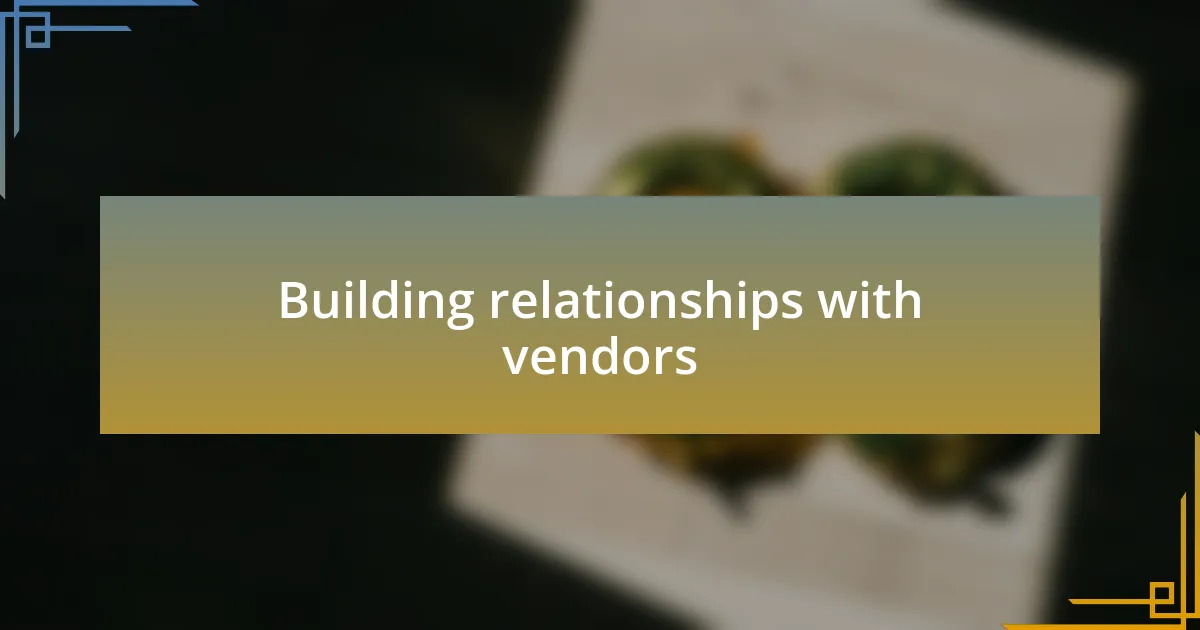
Building relationships with vendors
Building relationships with vendors goes beyond transactional interactions; it’s about creating a network of support and understanding. I recall a time when I partnered with a caterer who took special care to accommodate dietary needs. That attention to detail not only pleased my clients, but it also fostered a deeper appreciation between us. Have you ever noticed how a little extra effort can transform a simple working relationship into a lasting partnership?
Being approachable and genuinely interested in a vendor’s work can yield incredible results. After hosting a successful wedding, I invited the florist out for coffee to discuss the trends she was seeing in floral designs. This conversation revealed not only her passion but also her insights into upcoming styles, which I couldn’t wait to share with future clients. Isn’t it fascinating how taking the time to connect personally can enhance both your knowledge and your business relationships?
Ultimately, the relationships I’ve built with vendors have become invaluable assets in my planning journey. I often find that when I treat vendors as collaborators rather than just service providers, it sparks creativity and reliability. It’s these connections that lead to better experiences for couples, wouldn’t you agree? By nurturing these relationships, we all contribute to the magic of each wedding, creating a vibrant community within the industry.
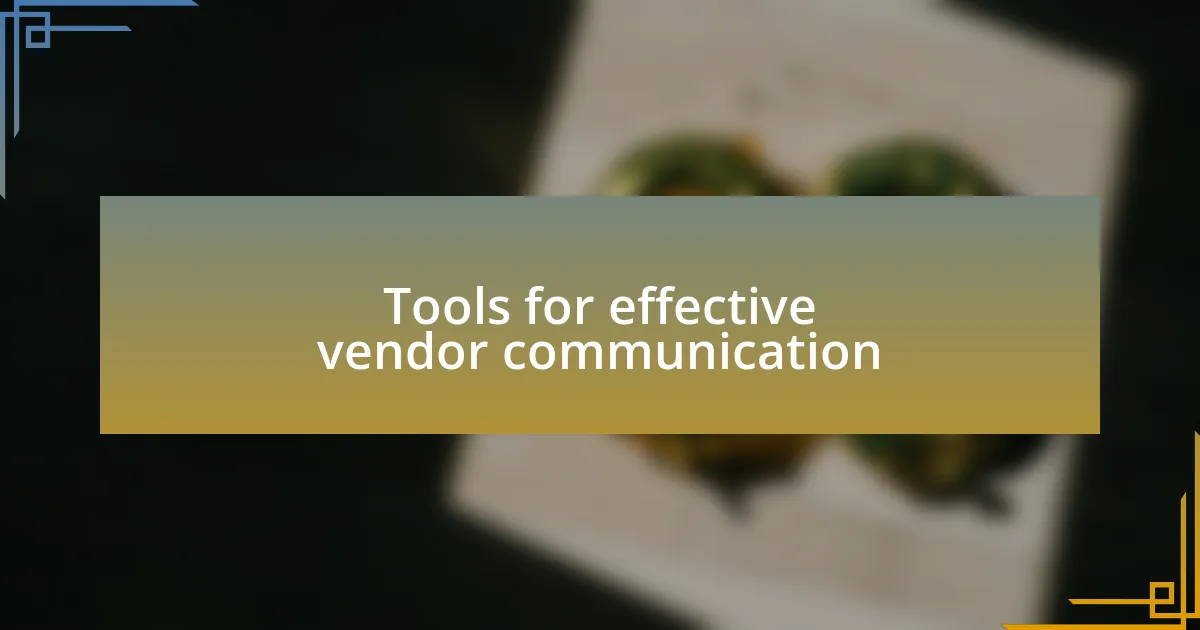
Tools for effective vendor communication
Good vendor communication is partly about finding the right tools to ensure everyone is on the same page. I’ve found that using project management software, like Asana or Trello, has transformed how I interact with vendors. This digital space allows us to track tasks and deadlines together, almost like having a conversation without the clutter of endless emails. How often have you wished for a centralized hub to keep everyone organized?
In my experience, instant messaging apps like Slack can be game-changers for real-time communication. There’s an immediacy in being able to ping a photographer about last-minute adjustments or confirm timings with a videographer right on the spot. It’s a feeling of connection that traditional emails just can’t replicate. Have you ever had that moment where a quick chat resolved a potential hiccup before it snowballed?
I also appreciate tools like Google Drive for sharing documents and inspiration boards. I remember collaborating with a venue manager on layout ideas; having access to images and files in one place facilitated open discussions and immediate feedback. The beauty in this is that it fosters creativity and ensures that everyone feels involved in the process. Isn’t it energizing to see how technology can enhance our relationships while making the planning process smoother?
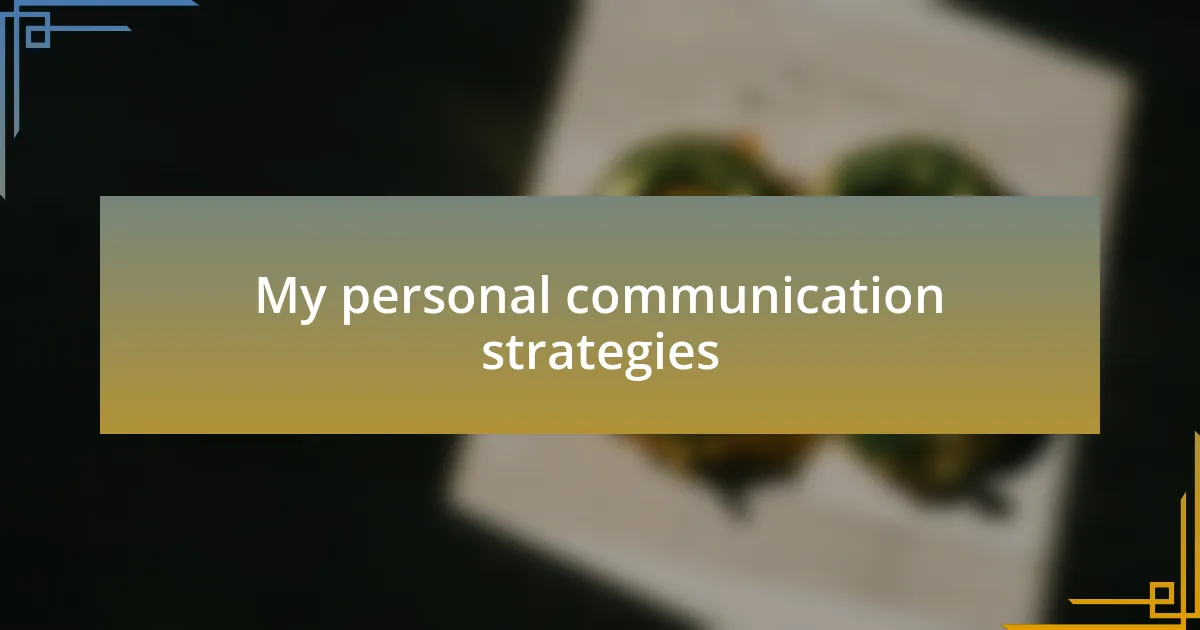
My personal communication strategies
Maintaining open lines of communication with vendors has always been a priority for me. I learned early on that regular check-ins, whether through quick texts or scheduled video calls, prevent misunderstandings. One time, I reached out to a florist just to confirm the color palette, and the discussion opened the door to some creative ideas about arrangements that changed our entire vision.
I also make it a point to personalize my interactions. A simple “thank you” or a compliment about their previous work can go a long way. One vendor I worked with appreciated my acknowledgment of their hard work on Instagram. This small gesture helped build a stronger rapport, and I felt more comfortable discussing my ideas and feedback openly. Have you noticed how a little kindness can transform a business relationship?
Furthermore, I find that setting clear expectations from the start helps create a smoother communication flow. For instance, I always outline my preferred response times and how much detail I expect in updates. This transparency has led to fewer surprises down the road, which I find alleviates common stressors during busy planning periods. Have you ever experienced the relief that comes when everyone is on the same page right from the beginning?
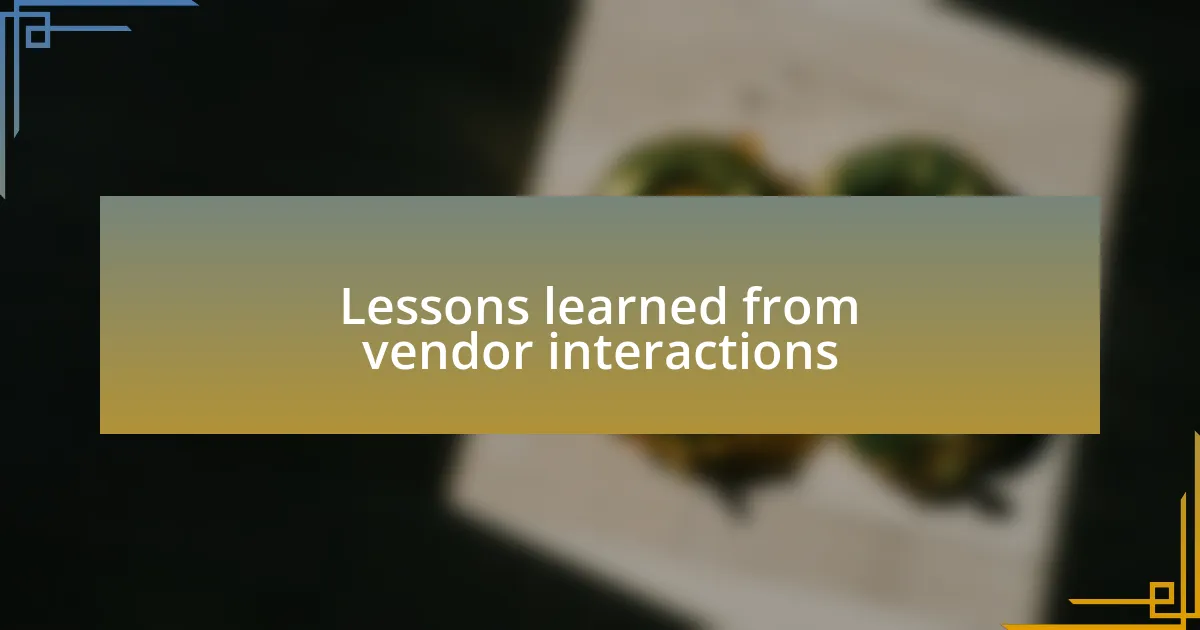
Lessons learned from vendor interactions
As I’ve navigated vendor interactions, one critical lesson I’ve learned is the importance of active listening. I recall a conversation with a wedding planner who shared invaluable advice about timing and vendor coordination. By genuinely hearing her concerns and insights, I was able to sidestep potential scheduling conflicts that could have derailed part of our day. How often do we listen, truly listen, beyond just the words spoken?
Another key takeaway from my experiences is to embrace flexibility when things don’t go as planned. There was a time when a photographer I hired faced a sudden emergency, and rather than panicking, I opted for a candid conversation about alternative solutions. This approach not only eased the pressure on both sides but led to a fantastic last-minute collaboration with another talented professional. Isn’t it fascinating how a little adaptability can lead to unexpected opportunities?
Lastly, I’ve found that following up after an event solidifies relationships for the future. For example, after our wedding, I took the time to send a handwritten note to each vendor, expressing my gratitude. This small act forged a lasting impression, and it’s rewarding to know that these connections often open doors for future collaborations. Have you ever wondered how a simple thank-you can leave a footprint in the tapestry of your vendor relationships?